Family travel
-
Suria Cherating Beach Resort
What is the best way to enjoy Cherating beach? To me, it is certainly walking along the shore and combing the beach to see and photograph things that have been washed ashore with the tide, while letting the gentle breeze kiss the face.

And where is the best place to stay after the excursion along the beach? Certainly going back to my choice of resort—Suria Cherating Beach Resort (Suria Cherating); the perfect spot to kick up my feet and continue to feel the breeze. I love it here.
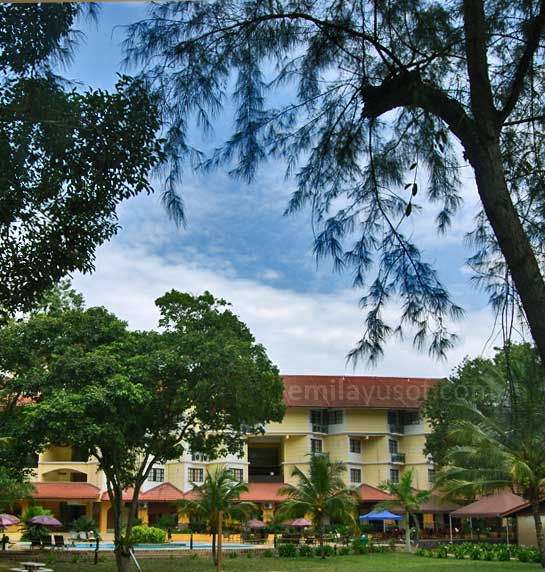
Suria Cherating is renowned for its Bali-inspired accommodations that spell comfort in style. Its 114 cozy guest rooms are decorated with stylish teak furniture with a touch of Balinese art. The room during my stay here was a two-bedded Superior room with a garden view. Choice of accommodations at Suria Cherating ranges from a variety of rooms with garden or sea view and amenities include TV with selected satellite channels, coffee/tea-making facilities, refrigerator, IDD telephone, ironing board upon request, wireless Internet connectivity in the room, safety box and more. Room rates are ranging from RM175 to RM345 (excluding tax), depending on type of room and time of year (normal day, school holiday, national holiday).
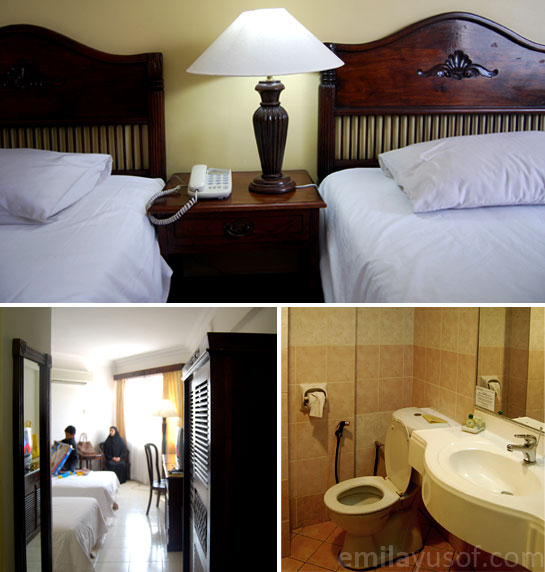
I love the corridor area where I got to view beautiful canvas paintings painted by local artist. At the end of the corridor there is an elevator and a gift shop and further down the steps is the swimming pool area, which overlooked by the Bunga Padi Restaurant. Right before the beach, there are dedicated areas for team-building obstacle course, mini playground, beach telematch and beach volleyball.

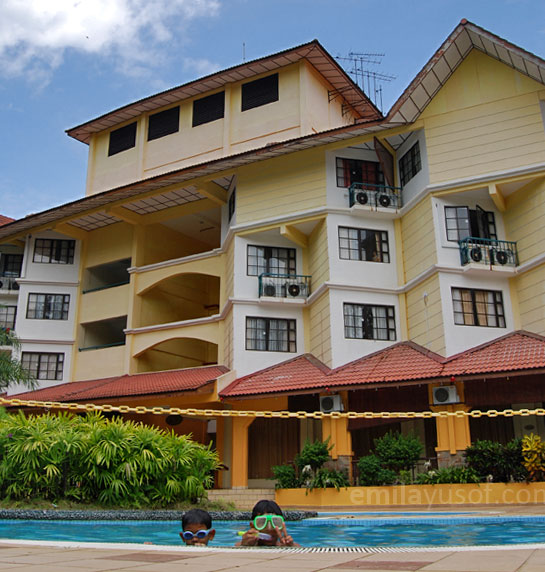
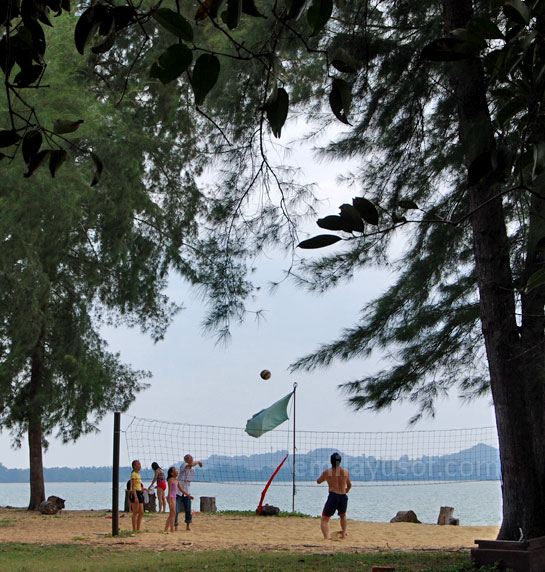
Buffet breakfast at Bunga Padi Restaurant was okay. There’s cereal with milk, toasted bread with jams or butter, sausages, baked beans, scrambled eggs, rice porridge, fruits and heavier food like fried rice and fried kuew teow. Alternatively, there will be nasi lemak or fried vermicelli or mee. Drinks include coffee, tea and orange juice. Breakfast is free for 2 persons. The rate is RM20 for adult, Rm13 for a kid. A-la carte is available for lunch and dinner and room service starts from 11am to 10pm. On arrival, all guests will be given a welcoming drink.
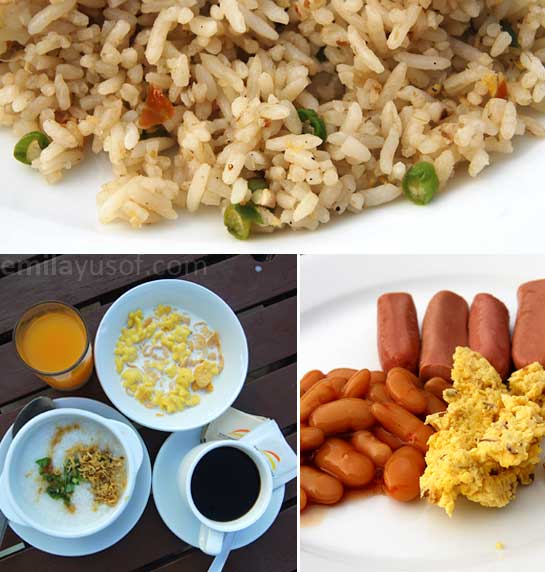
Overall, my stay here was great. My son enjoyed playing at the beach, the swimming pool and the playground area. And as for me, I mostly enjoyed walking along the beach and sitting outside the restaurant watching kids playing while taking pictures. I wanted to draw but I left my pencil somewhere and was not much in the mood to draw.
Because I enjoyed the stay so much, I want one of my lucky readers to have the chance to stay here too. Suria Resorts & Hotels management has kindly agreed to sponsor a 2D and 1N stay in a Superior room!!
To stand a chance to win, you need to:
- leave a comment why you deserve this stay,
- share this entry on social media,
- share Suria Resorts & Hotels website http://www.suriaresorts.com on your Facebook or Twitter,
- follow Suria Resorts & Hotels on FB.
Easy 4 steps! The lucky winner will be selected based on the most creative comment. Judging will be done by Suria Resorts management. Closing date is 11 September 2012, 11.59pm.
**********
About Suria Resorts & Hotels:
Suria Resorts & Hotels is a Malaysian – based resort and hotel operator and management company founded in 2003. Suria Resorts & Hotels presently managing a chain of hotels in Merang, Terengganu; Cherating, Pahang; Johor Bahru, Johor; Janda Baik, Pahang and Cambridge, London.For more information, please visit: http://www.suriaresorts.com or visit Suria Resorts & Hotels on FB.
For inquiries, please contact 03-7806 4752 or e-mail: sales@suriaresorts.com.
**********
-
Top 7 Family Activities in Kuala Selangor
If you want to visit Kuala Selangor with your family but have no idea where to begin, don’t worry, here is a list of the Top 7 Family Activities in Kuala Selangor that I compiled based on my trip just to give you some ideas of where to go and what to do.
1. Take the train ride up to Bukit Malawati — The train will take you and your family around Bukit Malawati and it will stop at the summit where you can hop off and do other activities. You can later hop on another train to continue the ride down the hill and later to Freshwater Park and Kuala Selangor Nature Park and a bit of the town. Attractions along the ride include Royal Tomb, Poisonous Well, 100 Steps and Seven Wells. The fee for a complete ride is RM3 for an adult and RM1 for a kid.
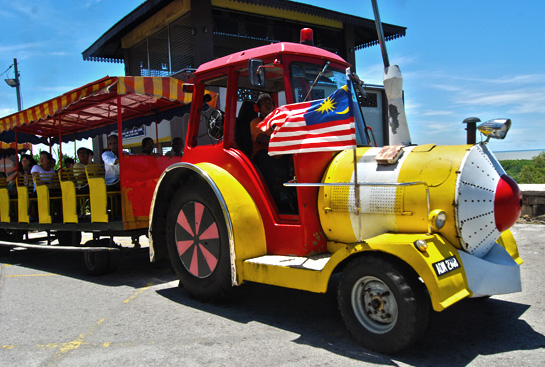 Colourful train ride.
Colourful train ride.2. Play and take pictures with Silver Leaf monkeys — Hop off at Bukit Malawati summit and get to see tens of Silver Leaf monkeys. These monkeys were quite playful and some even sit still to allow you to take photos with them. If you are into animal photography, this is the time to get close to them and take loads of pictures. You can buy a bundle of food for RM2 from a peddler to feed the monkey but please take note that it is not encouraged to do so as it will disrupt their natural feeding habits.
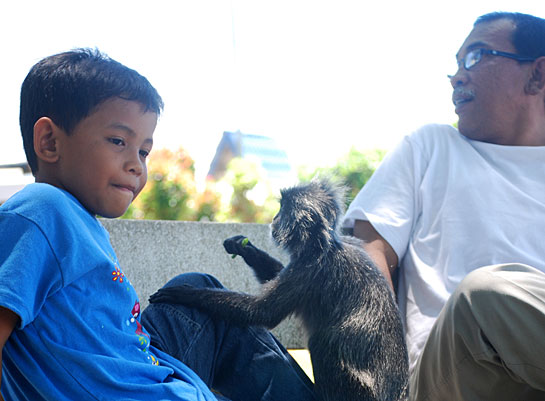 Please keep your children under supervision at all times.
Please keep your children under supervision at all times.
A female Silver Leaf monkey with its baby.3. Visit the Historical Museum of Kuala Selangor District — This is a place where you and your children can learn how Kuala Selangor got its name, who were the Sultans, how the hill became a battlefield and many more. You can use the new-found knowledge to play History Q&A fun games with your children in the car. Admission is free and the museum opens from Tuesday to Sunday from 9.30 am to 5.30 pm.

4. Take a walk at Kuala Selangor Nature Park (KSNP) — This is a great place to instil a love for nature and the environment into children. KSNP is managed by the Malaysian Nature Society(MNS) for the Selangor State government. This park comprises 324 hectares with four rich habitats, namely: secondary forest, mangroves, brackish water lake and coastal mudflats. KSNP operates daily (including Saturday and Sunday) from 8:30 am to 6:00 pm. Admission Fee is RM4 per adult and RM1 for student and children below 16. Malaysian Nature Society members pay RM2.
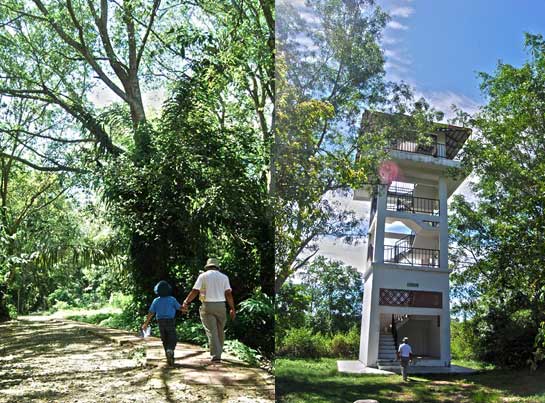 Left: My son and husband are real walkers, I could not keep up with them. Right: An observatory tower.
Left: My son and husband are real walkers, I could not keep up with them. Right: An observatory tower.5. Kuala Selangor Freshwater Fish Park — Located just next to Kuala Selangor Nature Park, this fish park houses about 1500 fish from 60 species, mostly from rivers and peat swamps in Selangor. The history of freshwater fish in Kuala Selangor and the type of traps used by fishermen can be seen in the Freshwater Fish Gallery. Entry into the park is RM2 per adult and it opens from 9.30 am to 4.30 pm daily.
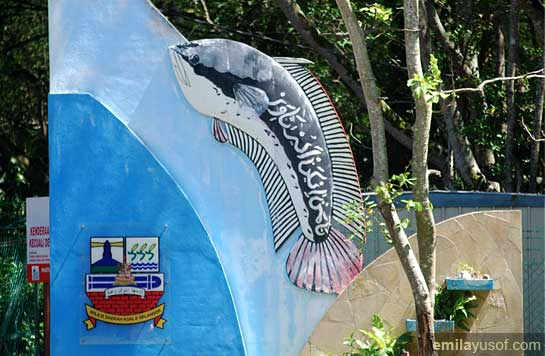
6. Light up your night at Kg. Kuantan Fireflies Sanctuary — Here is a chance for you to have that enchanting hour when creatures of the forest wake from their afternoon slumbers and venture out to play at dusk. The park opens from 7.30 pm until 10.30 pm and the fee for a boat is RM40 (for 4 persons).
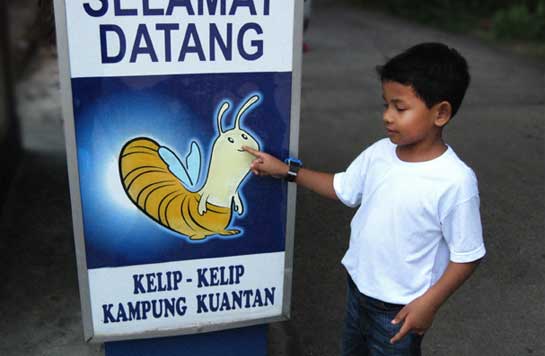

7. Have your dinner at Medan Ikan Bakar Pantai Jeram — Take your family to this seafood restaurant at Pantai Jeram located about 18km south of Kuala Selangor town, along the coastal road to Klang. The food here was great and we spent about RM100 on Chili Crab, Grilled Fish, Grilled Squid, Mixed Vegetables, tomato soup, rice and drinks.
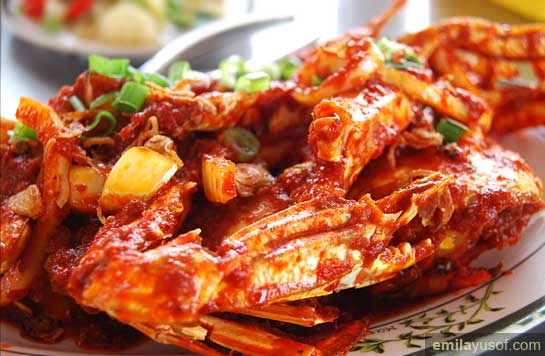


Kuala Selangor is just about an hour’s drive from Kuala Lumpur and to get to Kuala Selangor, you can opt for The KL-Kuala Selangor Expressway (LATAR Expressway) linking Kuala Lumpur at Templer’s Park in the district of Gombak with the township of Ijok in the district of Kuala Selangor. This expressway is the alternative link road to Federal Road 54 (Jalan Sungai Buloh – Kuala Selangor).
Here are more posts of Kuala Selangor:
– De Palma Kuala Selangor
– Bukit Malawati, Kuala Selangor
– Kuala Selangor Nature Park
– Kg. Kuantan Fireflies -
Kuala Gandah National Elephant Conservation Centre
Visiting Kuala Gandah National Elephant Conservation Centre at Lanchang, Pahang last month was a great opportunity for my family and I to learn more about elephants as well as to meet and greet them up-close and personal. Reaching the place around 12.30pm, I went in the reception area with my son to find out more information about the place while my husband takes a quick nap.
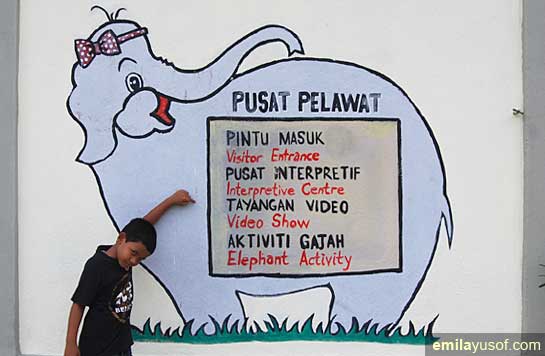
National Elephant Conservation Centre is a base for Elephant Relocation Team dedicated to locating, subduing and then trans-locating problem elephants from areas where their habitats are constantly being encroached by plantations, to other suitable habitats throughout Peninsular, including Taman Negara National Park.
We found out that admission is free and in order to get in the sanctuary, we need to register; full name, IC, address and phone number. Later we were given sticker passes to stick on our shirts. By having done all that, we’re free to visit the sanctuary already but activities with elephants only starts at 2pm, so we use the extra time to visit the exhibition near the reception area to learn more about elephants.
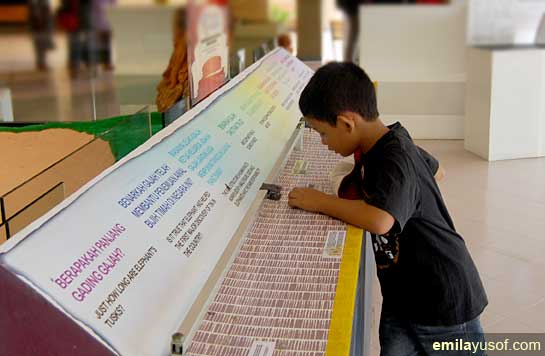

At around 1pm, we went into the area where the elephants are. Although activities have not started yet, visitors can go in and see and feed the elephants.
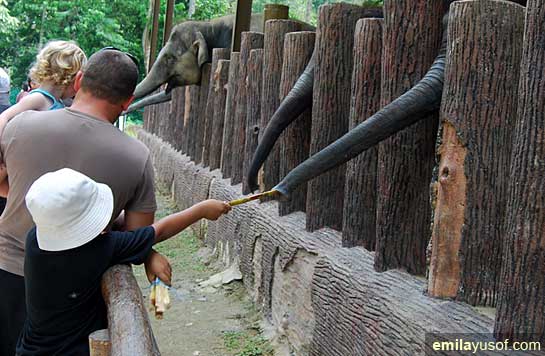
Here is Yassin feeding an elephant with sugarcane.Some of the elephants here were found injured in the jungle of Malaysia while some were brought in from Thailand and Myanmar under the trans-location program to ensure their well-being and continued survival.
The Peninsular Malaysian elephants (Asian elephants) are listed as critically endangered species as there are only 1,200 wild elephants existed in Peninsular Malaysia. Protecting these elephants help safeguard thousands of other species within its habitat. The elephant creates vital natural pathways by knocking over trees, allowing smaller species to feed, as well as dispersing plant seeds in its dung. However, due to habitat loss, elephants are forced to hunt for food in convert areas surrounding forest such as plantations, where they raid crops on a massive scale. This is why the trans-location team has such a dire responsibility to move these elephants, to prevent them from otherwise being shot by farmers, or simply dying of starvation.
The activities kicked off at 2pm with an introduction of 6 elephants. These elephants are highly intelligent and delightful – each one has a different character, personality and temperament. All of them showed off a bit of their talents.
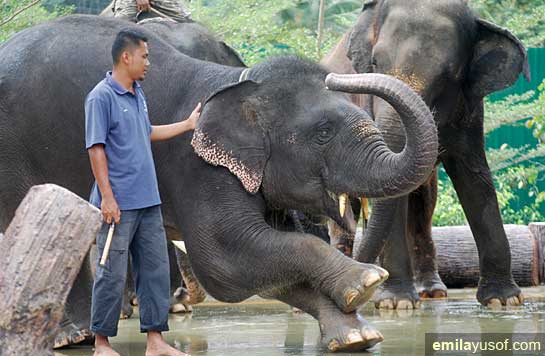
An elephant saying thank you.Later, we got to interact with elephants by touching and feeding them. Yassin was so happy to be able to do that.
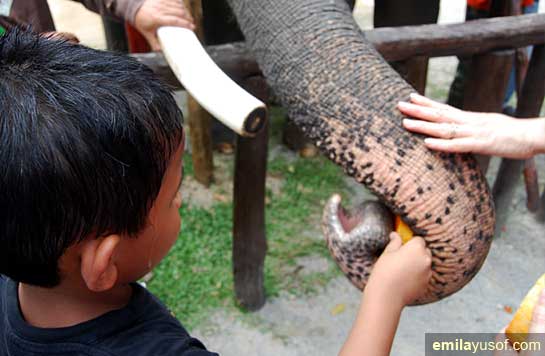
Touchy moment.After the feeding session, all visitors were allowed to ride naturally on the elephants; without seating basket and all. The queue was quite long…we waited almost an hour.
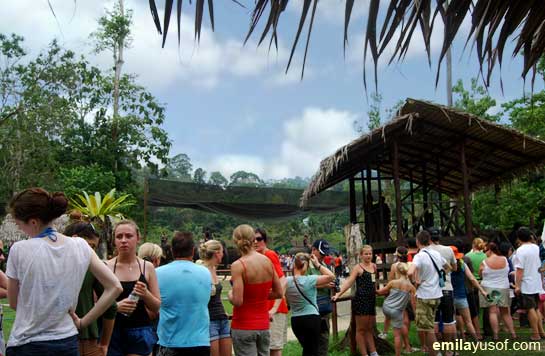
Long queue.
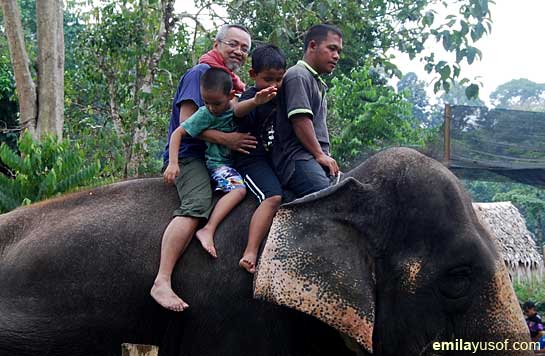
Yassin with Ali and Uncle Helmy. Whaddaya know; of all the places, we bumped into them here at the sanctuary. Ali loves elephant.Last activity of the day was bathing with elephants! Everybody; young ones and old alike, were very much excited. Yassin and Ali was having a blast washing the elephant. I did not join the the fun as I like being dry and just take photos. My husband joined in to take closer pictures in the river.

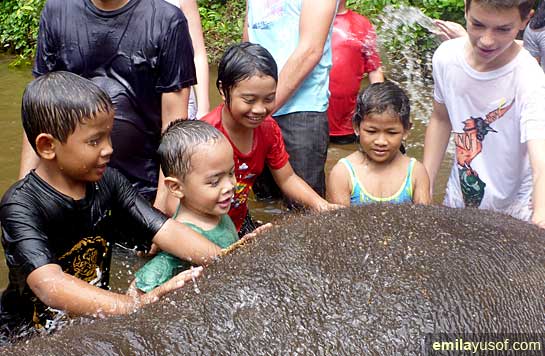
The bathing activity ended around 5pm and just before we could get to our car, rain fell down. So, my clothing was wet in other way. Ah well, hujan rahmat. Been quite a while since I last got soaked in a rain.
Here’s a video to sum it all up:
-
Exotic animals at Deerland Park, Lanchang, Pahang
Visiting Deerland Park in Lanchang, Pahang not only gives the opportunity to meet deers, but to also to meet a collection of pheasants like Golden Pheasant, Vulturine Guineafowl, common pheasants, other type of birds like quails, cockatiel, Mandarin duck as well as the four-legged ones; ferret, Bengal cat, Guinea pigs, rabbits not to mention the hissing ones; couple of pythons.
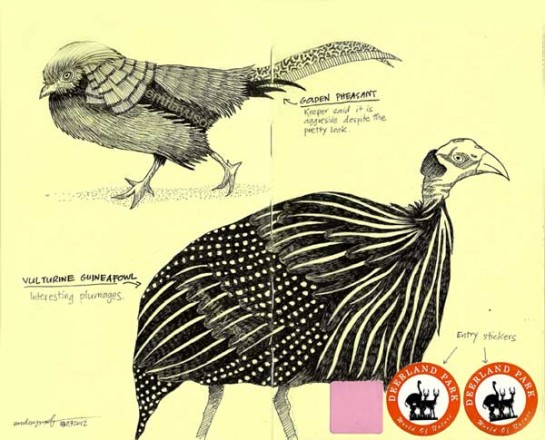 I found that these two pheasants have very interesting plumage so I took them as subjects for my pen drawing.
I found that these two pheasants have very interesting plumage so I took them as subjects for my pen drawing.Golden Pheasant caught my attention as it has a very beautiful intense shimmering plumage. The crest is in golden yellow and rump and bright red body. The deep orange “cape” or tippets can be spread in display, appearing as an alternating black and orange fan that covers all of the face except its bright yellow eye, with a pinpoint black pupil. According to the keeper, this pheasant is not that friendly despite it’s beautiful plumage. When it saw me aiming my camera, it came darting across the lawn and walk non-stop and made it hard for me to take the picture. Unlike Golden Pheasant, Vulturine Guineafowl has primarily bright blue body with interesting black and white streaks and dots on the back feathers. There is a band of tiny brown feathers on the back of its head and the eyes are fiercely red.
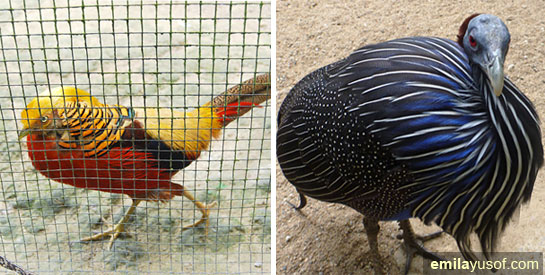
My son was in awe with the cute quails and the keeper told me that these were the meat-type not the egg-laying type. He also added that meat-type quails are bigger than egg-laying ones.

After walking around the corner of this quail area, I saw a couple of creepy crawlies! I dared not go near but my son and his dad went near and touched them! Yikes. I ran—like quail—away from the pythons and later got to meet a cockatiel.
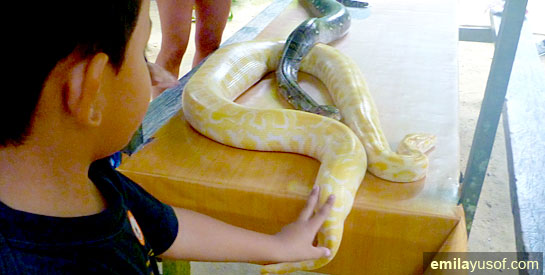
Photo captured by my husband.I looove this cockatiel! It has orange blush spot, so cute. I must draw this cute bird in color when time permits.
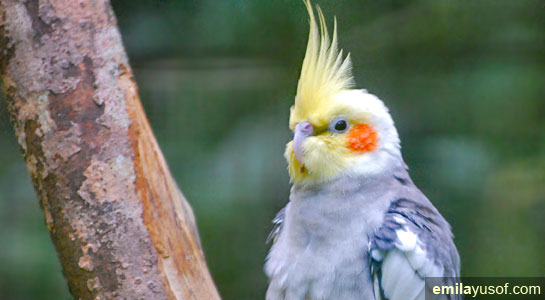
Cockatiel is an exotic bird, popular for its attractive yellow crest, bright orange patch in its cheeks and its long sleek tail. Cockatiel is usually gray colored, however, some domesticated cockatiel breeds are found in colors of yellow, peach, gray, orange and white.
And later we got to see Bengal cat sleeping. I called tsktskstsk (the sound when one calling out to cat) but it ignored, must be in deep slumber. The Bengal is actually a nocturnal loner and very shy—that explains why it was in deep slumber. The Bengal is a hybrid breed of cat, formed by the cross of a domestic feline and an Asian leopard cat (ALC). The Bengal cat has large spots, rosettes, and a light/white belly, and a body structure reminiscent of the ALC.
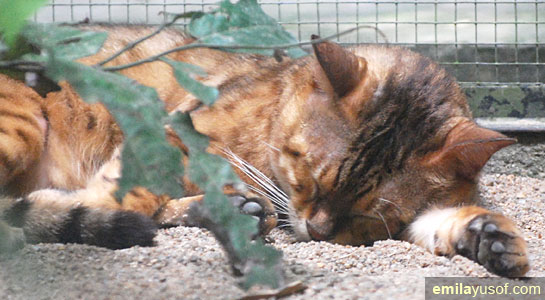
Next, we got to feed rabbits!

Later we got to see pretty Mandarin ducks. I love the plumage, so beautiful. This will be my next pen drawing subject too.
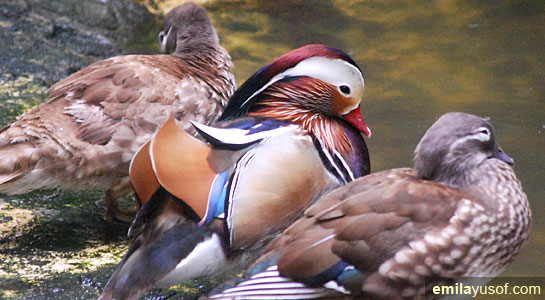
You see the pretty one in the middle? It’s the male one; the female ones are those two having not so attractive plumage. The male duck has a red bill, large white crescent above the eye and reddish face and “whiskers”. The breast is purple with vertical white bars, and the flanks ruddy, with two orange “sails” at the back. The female is similar to female Wood Duck, with a white eye-ring and stripe running back from the eye, but is paler below, has a small white flank stripe, and a pale tip to its bill.
And the mandarin duck ends our trip around Deerland Park. We really had great time here getting to know more animals. We waved goodbye to the animals and dropped some donation to support them before we leave.

-
Pulau Ketam, Selangor
Spontaneous trip is always fun. The art of not planning is what makes it more exciting.
Few weeks back on Sunday, my family and I went to Pulau Ketam after a morning walk at a park. It was unplanned and I mentioned to my husband that I would love to go and look what’s in Pulau Ketam and he said the magic word—let’s go. We took the Federal Highway and finding our way was easy, we just followed the signboards to Pulau Ketam Jetty.
We bought tickets at the price of RM7 per adult and RM4 per children (one way). 3 adults and 1 kid, to and fro = RM50. We boarded a ferry with a capacity of at least 70 passengers. Interesting trip as it took us through Pulau Klang to reach Pulau Ketam. The narrow channel is covered in mangrove swamp and is uninhabited.
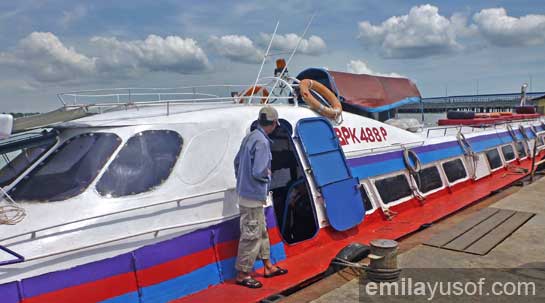
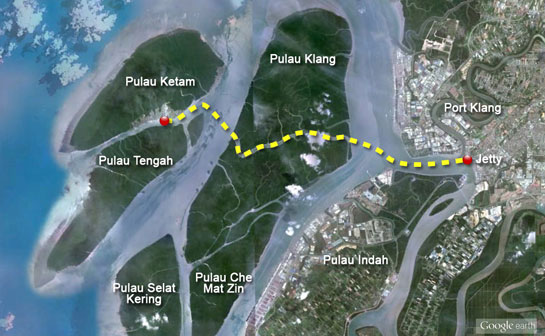
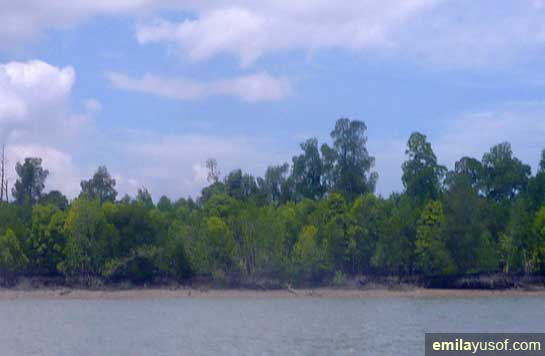
We reached Pulau Ketam in about 40 minutes time. We saw a lot of crabs when we arrived at the jetty—now we know how the island got it’s name, Ketam means crabs.
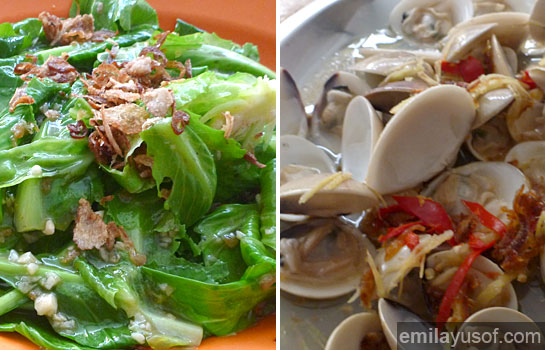
We had our lunch there before going around the village for a walk. We were quite hungry and below were the first two dishes that arrived on our table. The rest came later and I totally forgot to snap pictures. Haha. There are a lot of seafood restaurants here and we picked one with a Bismillah signboard. It’s a Chinese restaurant that serves only seafood and I saw that a lot of Muslims came here to eat. I totally forgot the name of this restaurant. But if you come from the jetty, take Jalan Dua and look for a restaurant with the Bismillah sign, it’s on your right side.
After lunch, we went around the fishing village to look at how a fishing village look like mostly the area of Jalan Timur and Sungai Satu. Pulau Ketam is equipped with almost all the basic facilities—there’s hospital, police station, surau, fire station, power station, post office, bank, hotel and shops. Pulau Ketam is free from traffic jam as the main transportation here is bicycle.
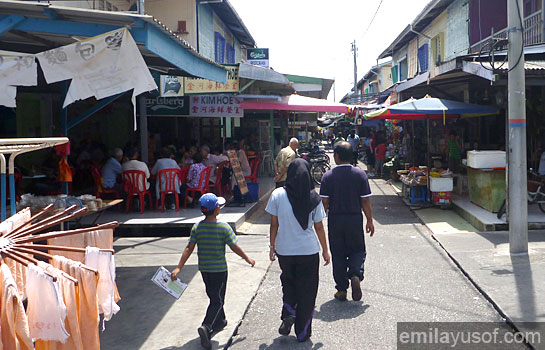
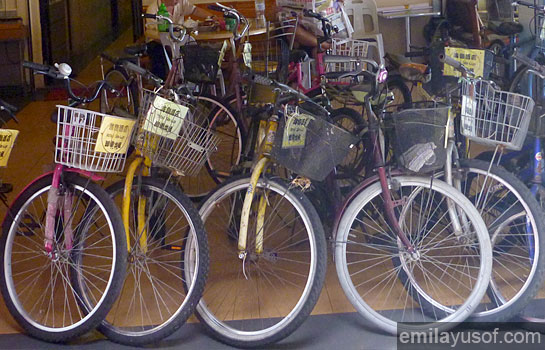
Pulau Ketam was founded when three Hainan fishermen from Bagan Hainan, Port Klang, arrived at Pulau Ketam catching crabs for their living. At first, they came and returned to Port Klang daily. The journey took almost a day, so they built a small house to stay overnight. In 1872, they decided to stay permanently and built a temple named “Chuan Eng Bio” located near Jalan Timur. In 1883, the population increased almost to hundred and major activities were catching crabs, fishes and prawns. Some of them built sundries shops, and fish dealer shops. The locals are mainly Teochew and Hoklo (Hokkien) Chinese, with Teochew, Hokkien and Mandarin Chinese the main dialects spoken.
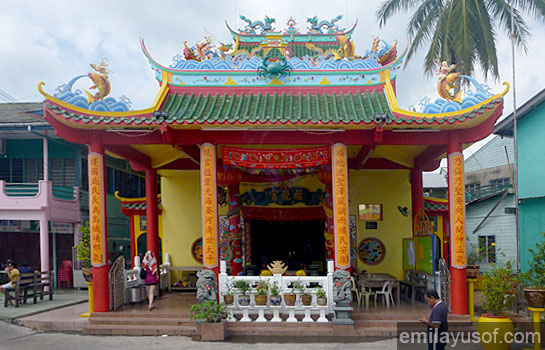
Chuan Eng Bio temple.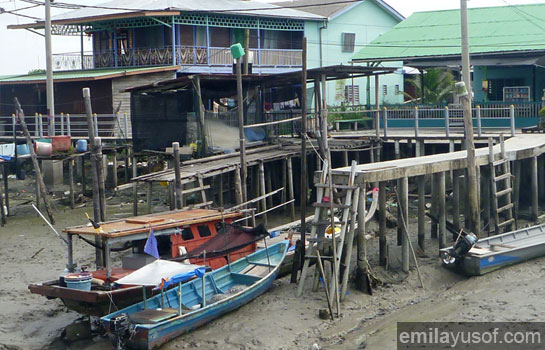
As we explored further, we saw houses and more houses built on stilts. I found it interesting that some of the houses have paintings on top of their windows. It is not just new year painting posted on top of their windows during Chinese festivals but more like a permanent fixture of decoration. Some of the houses have hanging lanterns too. I guess other than hanging it during festivals, lantern continue to be a means of artistic expression, both in terms of functionality, design, and decoration.
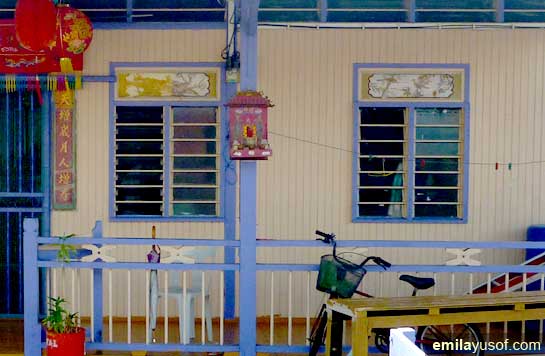
We came to the end of Sungai Satu where we reached a fish-dealer jetty. Fish dealing was not in sight as we came about 3pm. I think the dealing is in the morning. We took a rest before heading back the same way to the jetty.

We did not get to visit Floating Fish Farm is as we were already tired exploring the other part of the island. We will save the other part for later when time permits. I bought a map at Greenway‘s shop and perhaps I can take the Visit Fish Farm Package. For a trip for 4 persons, the price is RM60. The package will include around the island tour on a wooden boat before arriving at the Fish Farm. At the Fish Farm, there will be a tour guide to explain about fishes reared there. Or perhaps we can take the Day Time Fishing Package which cost about the same price. This will be interesting as my son, Yassin, is very keen on fishing. He has his own fishing rod.
References:
http://greenway2u.com/about.htm
http://en.wikipedia.org/wiki/Pulau_Ketam -
A visit to Deerland Park, Lanchang, Pahang
Frankly, I did not know a deer farm known as Deerland Park existed in Lanchang, Pahang. I discovered the place by chance.
My family and I, with a plan to visit Kuala Gandah Elephant Sanctuary, reached Lanchang at about 10am, Sunday, from Temerloh. We stopped by a restaurant somewhere in Kampung Chempaka Kanan to take our late breakfast and later bought some bottled water from grocery shop next door. The taukeh asked me whether I was going to visit the elephants. I said yes and he told me that the activities only start at 2pm. Since it was only 11am, he told me to visit Deerland Park and that the signs would lead me there. I thanked him for the information and told my husband about it. So, we followed the sign and found the place. When we parked, I saw a van full of tourists visiting the same place. I was a bit ashamed of myself; well, who wouldn’t? They came with a plan to visit the place while I, a Malaysian living in Malaysia, just discovered the place by chance. But I guess that is a good sign that tourists are given good information of where to go and what to visit.
We paid RM16 in total; RM12 for 2 adults, RM4 for a kid. We were given entry stickers (to stick on shirt) and a coupon for deer food. My son was really excited to feed the deers. At the enclosure, we exchanged the coupon and get two small baskets of deer food and fed the Javan Rusa deers. It was fun but deers can be quite aggressive sometimes. My purple shirt got chewed by a deer, probably mistaken me for purple sweet potato.
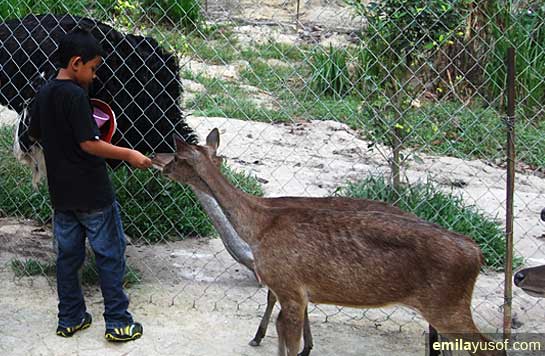
My son feeding Javan Rusa deer.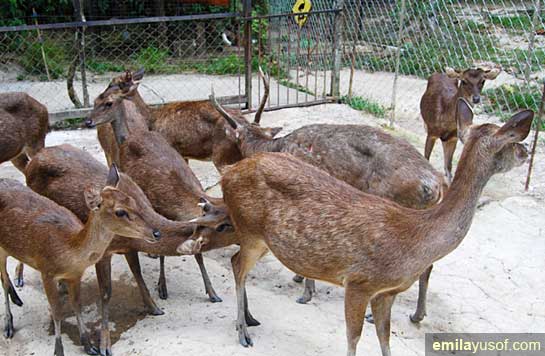
Javan Rusa deers are principly found in deciduous forests, plantations and grasslands in the islands of Southeast Asia. Javan Rusa lives between 15 to 20 years and rarely do they live for more than 20 years.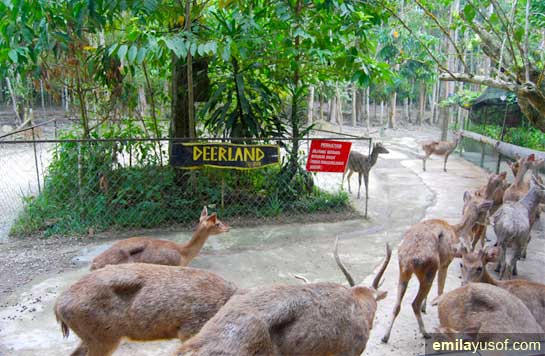
The deer enclosure here at Deerland park is quite big to allow deers to move about freely. The front area of the enclosure is for visitors to feed deers while surrounding area is very much a forest.Other than Javan Rusa deers, we got to see Sika deers and a mouse deer.
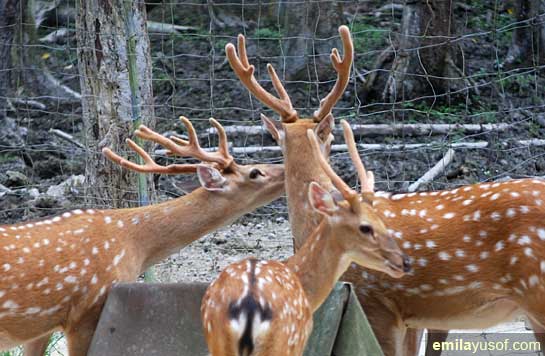
Sika deers are native to much of East Asia and introduced to various other parts of the world. Spot patterns vary with region.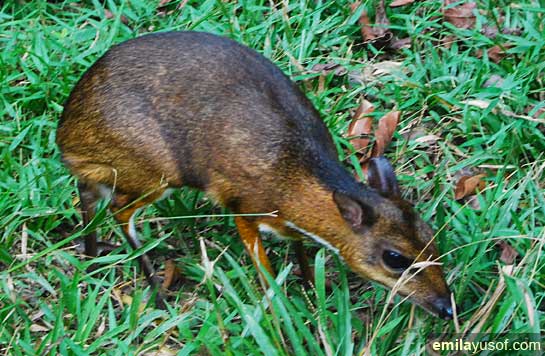
Greater mouse-deers are found in Sumatra, Borneo and smaller Malaysian and Indonesian islands, and in southern Myanmar, southern Thailand and peninsular Malaysia. They live near water, in tropical forests and mangrove thickets. They are terrestrial, but spend a lot of time in wet, swampy areas.Deerland Park is a great place to visit. A trip to this petting park is an opportunity for animal lovers to get up-close and personal with deers as well as a variety of animals such as Golden Pheasant, Bengal Cat, Rabbits, Parakeets, Phytons and few others. I’ll cover this on another post.
Deerland Park opens daily (except Friday) from 10.30 am to 5.30pm. To get here from Kuala Lumpur, take the Karak Highway to Lanchang, passing Karak along the way. Once in Lanchang, turn left into the road just before the BP gas station, then follow the road signs that show the way to Kuala Gandah Elephant Sanctuary. You will reach a junction where you can see a Deerland( 2km) road sign on your right.
http://www.deerland.org
http://animaldiversity.ummz.umich.edu/site/accounts/information/Rusa_timorensis.html
http://en.wikipedia.org/wiki/Greater_mouse-deer
http://en.wikipedia.org/wiki/Sika_deer -
Fraser’s Hill Day Trip
After having lunch in Damansara last weekend, my husband asked me, “where to next?” Instead of saying “home”, I said, “anywhere but here.” He replied, OK. Let’s go to Fraser’s Hill.” So, off we went.
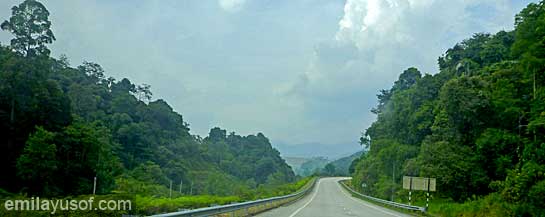
Road to Kuala Kubu.We took the Kuala Kubu Bahru route— E1, Route 1, Route 55 and Route 56—to reach Fraser’s Hill. We stopped by at Kuala Kubu Bahru town to buy USB phone cable; one of the things that we should have a spare in the car during spontaneous trip like this. Lucky our car has USB port, so charging is easy. The phone dubs as GPS.
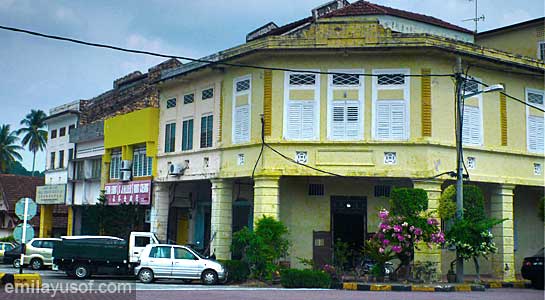
Kuala Kubu Bahru town.We drove across Sungai Selangor, passed by Selangor Dam and Chiling Fall and later found ourselves surrounded by thick forest of Selangor and Pahang. We wound down our side screens to smell the refreshing cool air filled with scent of trees and soil and perhaps Streptomyces too.
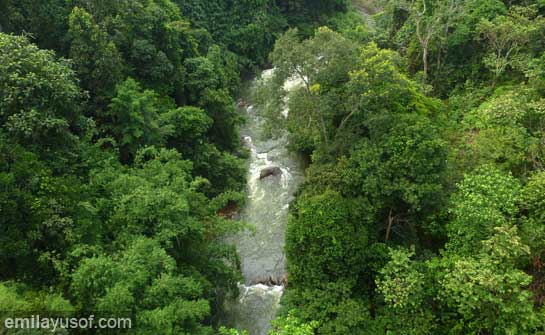
Aerial view of Sungai Selangor seen from the bridge on Route 55. Did you know that On 6 October 1951, Sir Henry Gurney was shot to death by the Communist guerillas on Route 55 while on his way to Fraser’s Hill for a meeting?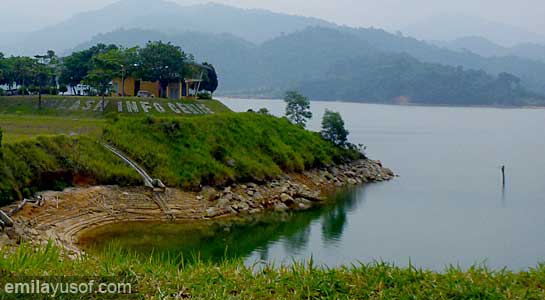
Empangan Selangor.
View on Route 56.After driving for about an hour from Kuala Kubu Bahru, we reached Fraser’s Hill.
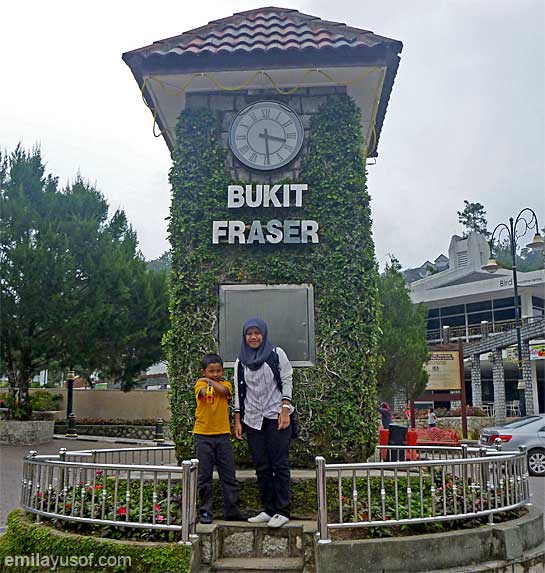
Yassin and his cousin, Wanda.It was a bit gloomy when we reached here and temperature was around 17°C, just nice to go for a walk around the hill—thanks to its 1524 m elevation. First place we visited was the clock tower, the British-looking little stone building covered with creeper vines. This most photographed clock tower was designed by Malaysian Landscape Architect Z. Jaal for Frasers Hill Development Corporation in 1989.
So…, what’s Fraser got to do with this hill station situated in Pahang? Who is Fraser? I bet the history is familiar to some of you but I love to write about it again as you might missed some of the facts that I found while doing my reading online and offline.
Fraser’s Hill is named after Louis James Fraser, a Scotsman who prospected for gold in Australia but eventually struck tin here instead in the 1890s. In 1900s, he went missing but only few years later, a big search for him was conducted by Bishop Ferguson Davie of Singapore. It was an unsuccessful search and some believed that his opium and gambling business got something to do with his disappearance (read: murder). I could not help but think that maybe he was attacked and eaten by tiger. Or, fell down from a ravine.
Anyway…Bishop Ferguson Davie, on the other hand discovered a perfect hill resort and suggested to the authorities to develop the area. By 1922 a road had been cut through the mountains to the valley, which soon sprouted bungalows and even one of Malaya’s first golf courses. Since then, Fraser’s Hill retains a wonderfully weird mixed-up character, where locals eat curries off banana leaves in an English cottage next to a golf course while the call to prayer sounds from the mosque.
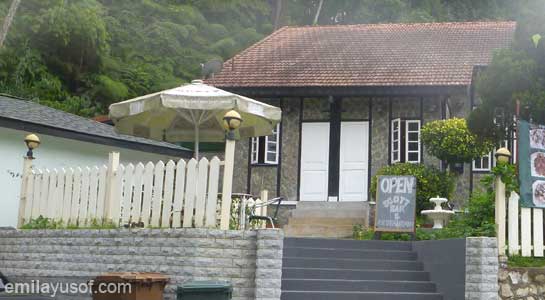
A colonial building converted into a bar and restaurant. A Scottish one. To commemorate Fraser, I suppose.Ok, enough with the history.
After the clock tower we visited Allan’s Water; an old dam which was converted into a lake. The dam was formerly served as a reservoir supplying fresh water to Fraser’s Hill. Since it was no longer used, it is converted to a recreational lake, providing boating and picnic activities for visitors. The name Allan’s Water was a tribute to Mr J. H. Allan, an assistant engineer who surveyed the area and mooted the idea of building a dam there.
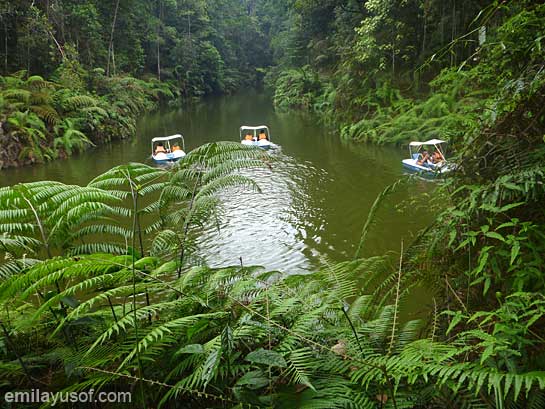
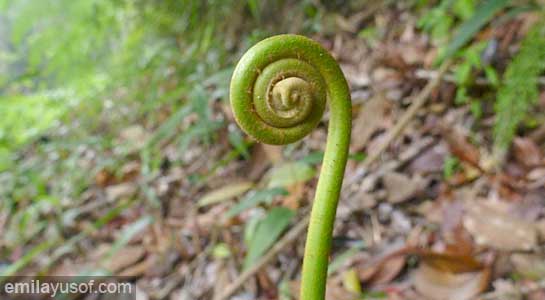
We did not went on the boat but we walked along the trail at the right side of the lake. It was here that a LEECH decided to make me a victim. Tolong!! I was screaming like crazy but my husband and son laughed at me. While my niece was comforting me saying to just let it fall by itself, I took a twig and get it OFF me. Crazy la, such a scary experience. LOL.
After Allan’s Water, we visited a flower nursery next to it. Previously, it was a flower garden but had been closed down for four years previously. A new owner took up the space and the nursery has been opened for almost 10 months now. It is still in its stage of adding more plants but one thing for sure, they have a mini strawberry farm here. We got to taste it and it was sweet! Unlike those sour strawberries I bought from supermarket. My husband bought a pot to care for. The nursery worker told us that a pot of strawberry plant can make up about 50 more and he later taught us how to go about it.

Later we just wandered around the hill taking pictures. We passed by some of the nature trails; namely Bishop Trail, Mager Trail, Kindersley Trail but as we were not ready for long trails, we skipped the idea. Trail’s length are ranging from 500m (Abu Suradi Trail) to 5km (Pine Tree Trail). While passing by the latter, I saw that it was sealed with no-entry tape, almost certain that it was closed for the day or perhaps for good. Do check with the information counter at Puncak Inn near the Clock Tower if you wish to go on one of the trails.
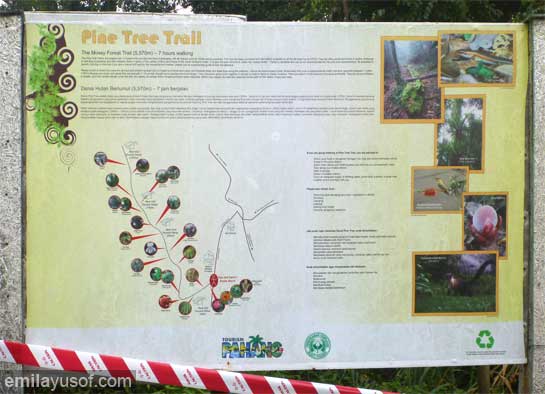
Before we get home, I captured some photos of flowers. I’ll cover more about flowers found in Fraser’s Hill in another post. we did drop by Smokehouse for coffee/tea but too bad that it was just closing for the day. It was around 6pm. But I did take some pictures.

Bibliography:
http://wikitravel.org/en/Fraser’s_Hill
http://en.wikipedia.org/wiki/Malaysia_Federal_Route_55
http://www.thesmokehouse.my/?page_id=2
http://www.fraserhill.info/
http://en.wikipedia.org/wiki/Fraser’s_Hill